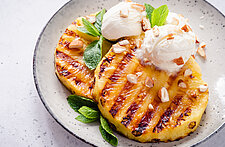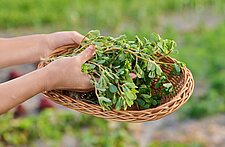In an interview with Chef Alejandro Morgan, Emmanuel Laroche, Symrise’s Vice President, Marketing & Consumer Insights, Global Marketing Leader, discussed how the Chef’s Costa Rican background influenced his menus at his San Francisco restaurants. Chef Morgan is the Executive Chef at Lolinda (lolindasf.com), the Argentinean inspired steakhouse. In his rooftop restaurant, Chef Morgan and his staff offer Costa Rican favorites and popular choices from other Latin American countries – all with a modern flair, but deliciously authentic.
In the third and final installation of this interview Emmanuel and Chef Morgan discuss Latin ingredients and their influence on mainstream America as well as what we can expect to see in the future of Latin cuisine in the U.S.
What Latino ingredients do you think are going mainstream in America?
Chimichurri is one that I think if made correctly, it should be on everyone’s table. Ceviche is another that also needs to be properly made and not excessively lavorful. Some of the fruits and vegetables that you find in Central America, you just cannot get here in the States. You cannot get some fresh Latin American gredients in supermarkets. Lucuma (fruit from Peru) is something you can rarely get here, although I do find it in the market near me. You also have a hard time finding Guanabana, known as Soursop here and Jocote. You may find it as a powder or in a concentrate, but getting it fresh is very difficult. Then Pejibaye or Peach Palm - you boil it for a long time, split it half and eat it with mayonnaise and it looks like a deviled egg. You can find it as street food all over osta Rica where it’s sold by the pound.
As far as desserts, are there Latin American equivalents to rice pudding served here in the U.S.?
We do have rice desserts in many parts of Latin America, but they are very, very sweet. Much sweeter than what most Americans associate with rice pudding. You can find a lot of desserts on street stands. There’s popular fried dough that resembles tortillas, and they are served with a honey-type syrup. In Costa Rica, it’s made as a thin, round pastry that’s about 12 inches in diameter. They’re called Prestinos. They look more like doughnuts when they’re made in Peru. More and more, Latino desserts can be found in the U.S., especially in Key West.
In addition to Peruvian cuisine, what other Latino cuisines are appearing in the U.S.?
Caribbean style food is getting a lot more popular – Puerto Rican and Dominican foods in particular. In many cases, they use the same ingredients, like Sancocho. Puerto Rican and Dominican foods share an African heritage. We’re seeing these foods in New York. An important trend we are seeing in the U.S., especially on the West Coast, is the modernization of Latino food. Many cooks, including myself, have been traveling to Spain where much of Latino food finds its roots. I see this as an up and coming influence. While Peruvian and Cuban foods have been a dominating influence in recent years, Caribbean will be very big in the near future.
Can we expect to see a fusion of foods from one Latin American country to another?
Rather than fusion, it’s more a matter of improving and updating recipes while not compromising flavor or authenticity. These foods are not generally known outside their own country. We’re making them more visually appealing in presentation, and we’re creating modern and professional ways of preparing them.
Take, for example, tostones, which we serve in the rooftop restaurant. We smash the plantain whole, fry it and refry it, and serve it with black beans, cheese and lime, so it’s esthetically appealing. Then there is Vigorón. Nicaragua claims it and so does Costa Rica – who cares? It’s just delicious. It’s made from yucca and plantain, served on the plantain leaf as a plate and usually eaten on the beach. We also use fried pork bellies, making them crispy and serve them with some pickled cabbage.
So we’re matching different tastes, making them look more appetizing yet keeping the taste that is natural to the particular Latin America culture to make them recognizable. It’s modernization, not fusion. As a youngster, I was tempted to think that home style food was boring, because there were things we ate every day. But this cannot be farther from the truth. They are delicious, not by mixing tastes from one Latin American country to another – but by the modernization of many of these wholesome foods, served in combination with each other, light yet rich in flavor with broad appeal.
Follow Lolinda on Twitter: @LolindaSF
Check out part 2 of the interview HERE
Check out part 1 of the interview HERE





